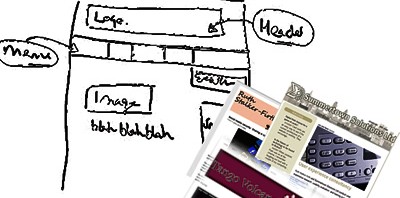Lately, it seems that I have come full-circle and am designing websites for small organisations which is, in part, how I began thinking about HCI, nearly 20 years ago. So, with all that experience, I am astonished to find that I have been making the same mistakes I used to make way back when. This leads to what I call ambivalent web design.
Ambivalent web design is when you are excited about creating a cool website to showcase your clients’ products and services as well as your skills as a designer. However, because you are unfocused, you keep changing your mind and then because it’s not looking as good as it could, you promise to deliver more to get it up to resemble the beautiful thing you now have in your mind. This can lead to you feeling annoyed at yourself and then resentful because the whole project is taking longer than it should for less money than the effort you are putting in.
In order to avoid ambivalent web design it is important to remember the following:
Don’t let casual interactions influence your work
You may have picked up the contract incidentally. Perhaps, it began with a conversation on the school playground, or you got a vague email from someone, but that doesn’t mean that you should behave in a casual, vague manner. Be professional. Organise yourself a plan of action and set clear milestones.
If you are not ready, say so. Explain to your potential client that right now is not a good time, and begin at a later date. Give the client a list of everything you might need, and get them to pick out sites they like so that you both have a clear idea of what you are aiming for during the design process.
Be realistic about your clients’ input
In general, clients who want you to design a website are not interested in website design. They don’t care about WordPress, nor have they desire to tinker with colour schemes, graphics, html and css. That is your job. If they wanted to spend time tinkering then they would go to WordPress.org download the software and do it themselves.
Consequently, it is important to be realistic about what they will do to maintain the solution that you give them, once you have been through the design process together.
Some questions that you need to discuss with the client:
- Who will maintain the site?
- Will they be able to do the necessary updates?
- Will they be able to add to the website?
Alternatively,
- Will the website be static until the next time it gets an overhaul?
Know your limits
With a content management system or blogging tool, such as WordPress, all things are possible. And that is great. However, things take time, especially if you need to go away and learn new stuff in order to fulfill your clients’ desires.
It is ok to say that you don’t know how to do something, and that it will just take more time and money to find the right solution. Bear in mind though, this is a tricky route, and potentially one way to resentment and ambivalence.
Have a price structure
You may have promised mates-rates, but you still need to calculate exactly how long it will take you to deliver what you have promised. One way of doing this is to have a price/time structure which you can show to clients so that together you have a focused way of discussing the work to be done.
You can structure your pricing according to time e.g, £X per day, or by output, e.g., six pages= 6 x £Z. And so on: personalised graphics will be £X, and some stock photos discounted down to £Y. A bit of social media will cost this, a little seo will cost that. In this way, the client can see exactly what they are spending their money on.
Have fun
Creating websites is a great way to spend your days, but, if you find yourself gritting your teeth during every project and feeling ambivalent, then perhaps it’s time to dust off your guitar and get back to busking.




